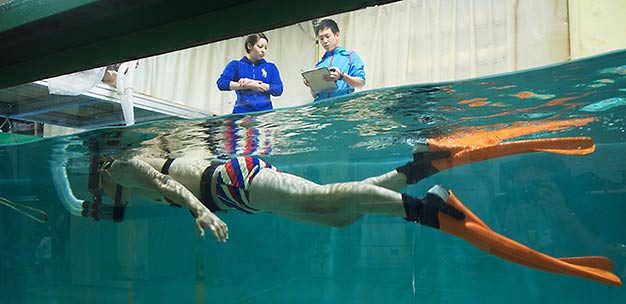Lightweight smartphone sensors and Newton's laws of motion can help athletes maximize their performance
Published online 21 January 2016

The accelerometers and gyroscopes found in today's smartphones can be used to improve the performance of swimmers, ski jumpers, and golfers, among other athletes.
© 2016 Yuji Ohgi, Keio University
As a young man, Yuji Ohgi spent several hours a day in the swimming pool perfecting his stroke. These countless hours of practice paid off ― at the age of 20 he competed in the preliminary trials to join the Japanese swimming team for the 1988 Olympic Games in Seoul.
While he was not quite fast enough to make the team, the experience helped shape his career. Ohgi soon hit on the idea that the accelerometers and gyroscopes that today's smartphones use to get their bearings might help athletes and their coaches work out the optimal body positions and movements to improve performance. This inspiration laid the foundations for 20 years of innovation and discovery in the field of sports biomechanics.
Most of Ohgi's work focuses of human athletes, but not all of it. In one project, he is applying his expertise to better characterize the movements of thoroughbred racehorses using special treadmills designed to take their weight.
"Newton's laws cover all sporting activities," says Ohgi, now an associate professor at Keio University's Graduate School of Media and Governance. "The mechanical properties can be formulated in almost the same way for people and horses. Once we understand the fundamental physics involved, we can comprehend the mechanics of any sport."
Stroke by stroke
Ohgi first worked on using accelerometers and gyroscopes, known as inertial sensors, to analyze athletic performance in 1995, when the watch manufacturer Casio provided his supervisor with funding to research the development of a sporting wristwatch. After investigating the technology's potential in martial arts and baseball, he naturally turned to the sport he excelled at ― swimming.
Traditionally, coaches used cameras to visually assess sports performance, but the bubbles and splashes generated as swimmers ploughed through the water would often obscure the picture, limiting the capture of key data. "Usually swimming training is a matter of trial and error, with swimmers and coaches trying out new stroke techniques. But nobody really knows which techniques are best," says Ohgi. "Using inertial sensors, we can calculate the stroke propulsive force to assess the most efficient techniques."
After scrapping some earlier models, in 2006 he developed a waterproof data logger that could be strapped around a swimmer's wrist and wirelessly send data on acceleration and angular velocity to a poolside device1. More recently, he has used chest-strap-based sensors, and he is currently developing software for swimming training.
Jump and swing
Ohgi has applied the same ideas he developed for swimming to many other sports.
In ski jumping, for example, athletes move at great speeds over large distances, making it difficult to capture movement and positioning in detail, even with high-speed cameras. Since 2005, Ohgi has been refining a system that deploys seven inertial sensors on a jumper's body and one each per ski, as well as a laser scanner to track trajectory2. The system can be used to measure aerodynamic forces during jumps and provides better understanding of the effects of small changes in body positioning.
Ohgi also worked with Keio University colleague, Associate Professor Ken Ohta, in a collaboration with the Japanese electronics company Seiko Epson Corporation to develop a lightweight golf-swing analysis tool. Again using inertial sensors, the device provides players with data on swing path, club and club-head speed, face angle and efficiency of energy transfer from the body to the club shaft. The device was launched in Japan in 2014, and the United States and South Korea in 2015.
Not only sportspeople benefit from Ohgi's work; he is involved in a study led by colleagues at Keio's Sports Medicine Research Center on whether regular exercise can reduce cognitive decline and dementia. As part of the study, he is using Microsoft's Kinect motion-sensing device to develop a way to analyze elderly people's gaits.
Looking to the future, Ohgi envisions technologies that generate data on sporting performance will come into their own at the 2020 Tokyo Olympics. As co-chair of the scientific committee of the Japan Swimming Federation, he hopes to initiate a project using machine learning to identify the characteristics of swimmers from video footage.
This, says Ohgi, will form part of the research foundations for a much more technologically advanced experience for those watching the games and other sporting events remotely. "I believe that by 2020, television audiences will be able to monitor things like the speed and energy expenditure of their favorite athletes," he says.
References
- Nakashima, M., Ohgi, Y., Akiyama, E. & Kazami, N. Development of a swimming motion display system for athlete swimmers' training using a wristwatch-style acceleration and gyroscopic sensor device. Procedia Engineering 2, 3035-3040 (2010). | article
-
Ohgi, Y., Hirai, N., Murakami, M. & Seo, K. in The Engineering of Sport 7, Vol. 2 (eds Estivalet, M. & Brisson, P.) 157-164 (Springer Paris, 2008). | article